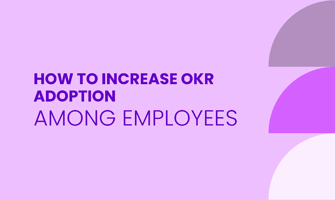OKRs (Objectives and Key Results) are a powerful goal-setting framework that helps organizations...
Common OKR Pitfalls and How to Avoid Them
Avoiding common OKR mistakes is important for your organization's success. Simple errors can reduce the effectiveness of your OKRs and make it harder to reach your goals. Fixing these problems helps keep everyone on track and improves overall performance.
The purpose of this article is to highlight these common OKR pitfalls and provide actionable techniques to avoid them. By understanding and addressing these pitfalls, you can enhance the effectiveness of your OKR framework and drive better outcomes for your organization.
To understand OKRs and how they can benefit your business, read "What is an OKR? A Beginner's Guide."
Importance of Identifying OKR Pitfalls Early
Spotting OKR mistakes early on is important for keeping your organization on track. Early identification helps maintain the effectiveness of your goals and keeps your team focused.
OKRs can boost performance and help you achieve your objectives when done correctly. On the other hand, if issues are not caught early, they can lead to inefficiencies and missed targets.
Early identification allows for timely corrections, ensuring that small problems do not turn into major setbacks. This proactive approach saves time and resources in the long run.
By learning about common OKR pitfalls and how to avoid them, you can create a solid framework that supports your organization’s success and strategic goals. This knowledge helps build a more resilient and adaptive organization.
![]()
Common OKR Mistakes to Consider and Avoid
1. Inadequate Security Measures
Inadequate security measures occur when there are weak protections in place for sensitive OKR data. This can happen due to poor encryption practices, insufficient access controls, and outdated security protocols.
When security measures are weak, the risk of data breaches increases, leading to the loss of sensitive information and a decrease in trust among stakeholders.
One reason this pitfall occurs is that organizations may not prioritize security updates or fail to educate employees on data security best practices. Also, rapidly evolving cyber threats require continuous updates and vigilance, which some organizations may neglect.
Techniques to Avoid Inadequate Security Measures
Implement robust security protocols: Use strong encryption methods like AES-256 to secure data. Ensure access controls are in place, such as multi-factor authentication (MFA), which requires multiple forms of verification for access, and role-based access control (RBAC), which assigns permissions based on a user’s role within the organization.
Regularly update security practices: Schedule quarterly security audits to identify and rectify vulnerabilities. Keep all software and systems updated with the latest security patches.
Train employees on data security best practices: Conduct monthly training sessions and awareness programs on the latest security threats and best practices. Use phishing simulations to test and improve employee awareness.
2. Scalability Issues
Scalability issues arise when the OKR system cannot support the organization's growth, leading to slow performance and system crashes. This typically happens due to limited system capacity and a lack of foresight in choosing scalable tools.
When systems are not designed to handle increasing data loads and user counts, they become overwhelmed, causing significant slowdowns or failures.
Organizations may face this pitfall because they underestimate their growth potential or choose cost-effective solutions that lack scalability. Without regular assessments and upgrades, the system's capacity becomes a bottleneck as the organization expands.
Techniques to Avoid Scalability Issues
Choose scalable OKR systems: Opt for cloud-based OKR software that can easily scale with your organization's growth. Ensure the software can handle increased data and user demands.
Ensure software can handle growth: Conduct stress tests to ensure the software can manage increased loads. Evaluate the software's performance during peak usage periods and plan for capacity upgrades.
Regularly review and upgrade system capacity: Set up a quarterly review process to assess system performance and plan for necessary upgrades. Monitor key performance indicators (KPIs) to identify when the system is approaching its capacity limits.
3. Poorly Defined Metrics
Poorly defined metrics are vague, subjective, or immeasurable key results that lead to confusion and ineffective tracking of progress. This occurs when key results are not clearly articulated or when they lack specific, measurable terms.
Without precise metrics, it becomes challenging to gauge progress accurately and make informed decisions.
This pitfall often arises because teams may rush the OKR setting process or lack the necessary training to define effective metrics. Also, there may be a lack of clarity on what constitutes a measurable and impactful key result.
Techniques to Avoid Poorly Defined Metrics
Use precise and clear metrics: Develop key results using the SMART criteria (Specific, Measurable, Achievable, Relevant, Time-bound). For example, instead of "Improve sales," use "Increase sales by 20% within Q3."
Train teams on setting measurable key results: Hold workshops to teach teams how to set effective OKRs. Provide templates and examples of well-defined key results.
Regularly review and refine metrics: Schedule bi-weekly OKR review meetings to assess the clarity and relevance of metrics. Adjust key results as needed to ensure they remain aligned with objectives.
4. Inconsistent Data Collection and Reporting
Inconsistent data collection and reporting occur when varied methods and unreliable tools lead to inaccurate tracking and decision-making. This inconsistency makes it difficult to maintain a clear and accurate picture of progress, leading to potential missteps and inefficiencies.
This pitfall happens because organizations might not have standardized processes for data collection or may rely on outdated or incompatible tools. Without consistency, data integrity suffers, resulting in poor decision-making and resource allocation.
Techniques to Avoid Inconsistent Data Collection and Reporting
Implement standardized data collection methods: Develop and enforce a standardized data collection procedure across all teams. Use a unified format and consistent intervals for data reporting.
Use reliable OKR software: Invest in reputable OKR management tools that ensure accurate and consistent data tracking.
Regularly audit data collection processes: Conduct monthly audits to ensure data collection methods are being followed correctly. Use automated tools to check for discrepancies and address them promptly.
5. Lack of Real-Time Tracking
Lack of real-time tracking occurs when tools do not provide timely updates and dashboards. This delay in identifying issues and making necessary adjustments can hinder progress and affect the overall success of OKRs.
Without real-time tracking, you may not be aware of issues as they arise, leading to missed opportunities for timely intervention.
This pitfall often happens because organizations might rely on outdated tools or fail to provide real-time access to all stakeholders. Without real-time tracking, decision-making can become reactive rather than proactive, affecting the efficiency and effectiveness of OKRs.
Techniques to Avoid Lack of Real-Time Tracking
Utilize tools that provide real-time updates and dashboards: Implement software that offers real-time data visualization and updates to keep track of progress continuously. 180ops provides real-time insights by combining CRM, customer service, and sales data with external data, helping organizations make informed decisions.
Grant access to all stakeholders: Ensure that everyone involved in the OKR process has access to real-time tracking information. This includes setting up user permissions and sharing dashboards with relevant team members.
Schedule regular review meetings: Conduct weekly or bi-weekly review meetings to discuss real-time data. Use these meetings to identify issues early and make necessary adjustments to stay on track.
6. Inadequate Integration with Existing Systems
Inadequate integration with existing systems leads to fragmented data and inefficiencies. This occurs when OKR tools do not seamlessly connect with other business systems, like CRM or project management tools.
Without proper integration, data silos are created, making it difficult to have a unified view of progress and overall performance.
This pitfall happens because organizations might select tools without considering their compatibility with existing systems or lack the technical expertise to integrate them properly. Inadequate integration can lead to duplicated efforts, data inconsistencies, and reduced efficiency.
Techniques to Avoid Inadequate Integration with Existing Systems
Select compatible OKR tools: Choose OKR software that can integrate seamlessly with your existing business systems, like CRM, and project management tools. Ensure that the software supports APIs and other integration features.
Conduct integration testing: Before full implementation, perform comprehensive integration testing to ensure that the OKR tools work smoothly with your existing systems. Identify and resolve any compatibility issues during this testing phase.
Hire or consult with integration experts: If necessary, bring in IT experts or consultants to help with the integration process. Their expertise can ensure a smooth and effective integration, preventing data silos and inefficiencies.
7. Data Silos
Data silos prevent cross-departmental collaboration and a unified view of progress. This issue arises when data is isolated within departments, leading to fragmented information and inefficiencies.
Data silos can restrict your organization's ability to make informed decisions and achieve its OKRs effectively.
Data silos often occur because departments use different tools and processes for data collection and storage, making it difficult to share information. This lack of integration can lead to inconsistencies and inefficiencies in tracking and achieving OKRs.
Techniques to Avoid Data Silos
Promote cross-departmental collaboration: Encourage departments to share data and insights regularly. Create opportunities for cross-departmental meetings and collaborative projects to break down silos.
Implement integrated data systems: Use integrated systems that centralize data storage and access. Ensure that all departments use the same platform for OKR management to facilitate easy data sharing.
Establish a unified OKR management platform: Deploy a single platform for managing OKRs across the organization. This platform should consolidate data from various sources, providing a comprehensive view of progress and enabling better decision-making.
8. Manual Tracking Processes
Manual tracking processes are prone to human error and inefficiency. This problem occurs when OKR tracking relies on manual updates and reporting, which can lead to inaccuracies and delays in tracking progress.
Manual processes can also be time-consuming and reduce the overall efficiency of managing OKRs.
Manual tracking often happens because organizations might not invest in automated tools or lack awareness of the benefits of automation. Relying on manual processes can lead to significant inefficiencies and errors in tracking and reporting OKR progress.
Techniques to Avoid Manual Tracking Processes
Automate OKR tracking: Implement dedicated OKR software that automates data collection, updates, and reporting. This reduces the risk of human error and ensures timely, accurate tracking.
Use tools with automation features: Select software that offers built-in automation for updates and reporting. These tools should automatically sync data from various sources and provide real-time updates on progress.
Train teams on automation tools: Provide comprehensive training to ensure all team members are proficient in using the automated tools. This training should cover how to input data, generate reports, and interpret automated insights.
![]()
Conclusion
Managing OKRs effectively is key to achieving your organization’s goals. Avoiding common mistakes ensures smooth operations and boosts overall performance.
By proactively addressing these pitfalls with actionable techniques, you can strengthen your OKR framework and improve efficiency. Implementing these strategies will help your OKRs be more effective and contribute significantly to your organization’s success.
FAQs
What are the most common mistakes to avoid when implementing OKRs?
Common mistakes include setting vague or unrealistic objectives, neglecting alignment across teams, overloading with too many key results, skipping regular check-ins, and failing to adapt the OKR process to your company’s needs.
How can I align OKRs across different departments?
Ensure each team’s objectives are linked to the company’s overarching goals. Conduct regular alignment meetings to review and cascade OKRs, maintaining a clear connection from top-level objectives down to individual contributors.
What are the best practices for setting realistic OKRs?
Use the SMART criteria (Specific, Measurable, Achievable, Relevant, Time-bound) to set clear and realistic OKRs. Involve your team in the goal-setting process to ensure the objectives are meaningful and attainable.
How do you ensure regular check-ins and progress tracking for OKRs?
Establish a regular check-in cadence, such as weekly or bi-weekly meetings, to discuss progress and challenges. Utilize OKR tracking tools or project management software to monitor progress and keep everyone accountable.
Why is it important to adapt OKRs to fit your company's unique needs?
Each company has unique goals, structures, and cultures. Adapting OKRs to fit your specific context ensures they are relevant and effective, promoting engagement and alignment across the organization.




